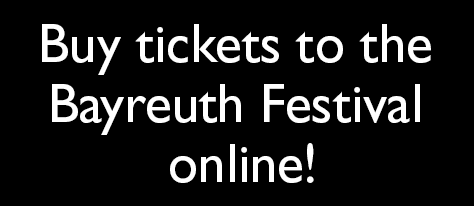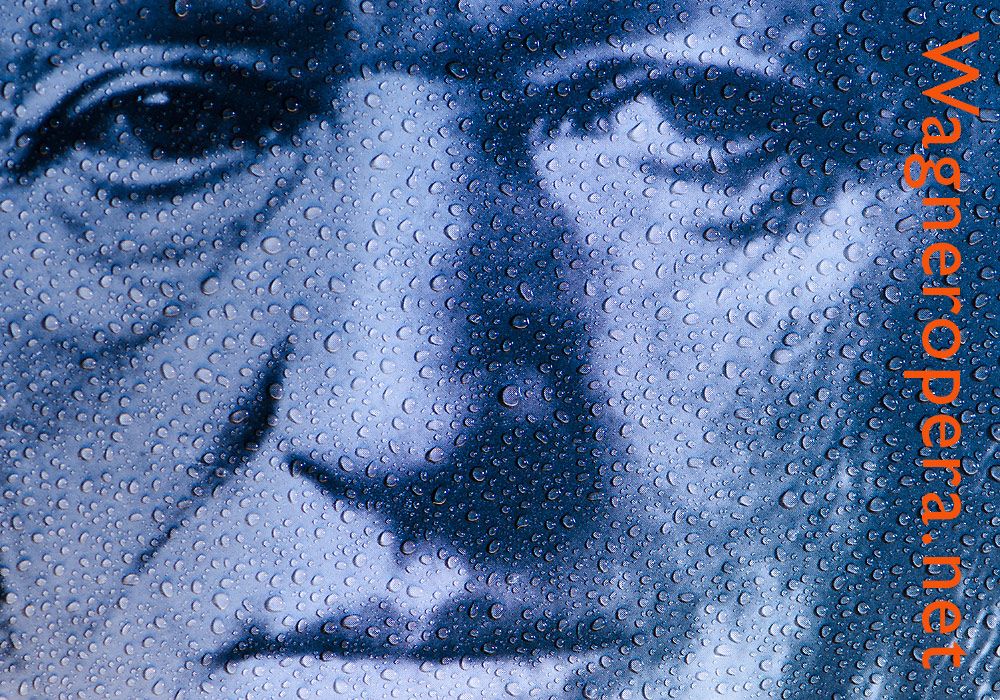Nila Parly on Regietheater
Visions of the Ring
Is there one truth, and one truth only, about the meaning of Wagner’s Ring des Nibelungen? Is it possible at all to uncover, in a scholarly way, the ‘truth’ about what the Ring means? And is it possible, on the basis of sufficiently documented research, to produce the Ring in perfect accordance with text, music and stage directions?
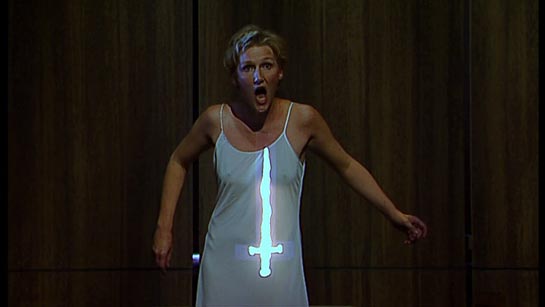
Sieglinde (Angela Denoke) in the Stuttgart Walküre: Should Siegmund's sword be in the tree or in Sieglinde?
You might almost think so, since passionately outraged Wagnerians so very often denounce a particular production as a total failure, claiming that the director has misunderstood the ‘proper’ meaning of the work.
This article has previously been published in The Wagner Journal and is reprinted with permission.
Stuttgart DVD Ring on Amazon
Order The Wagner Journal here
Nila Parly's homepage
A truly final, end-all staging of the Ring is a chimera, however, because any reading of it is a subjective interpretation; even the readings of scholars are subjective. Wagner’s tetralogy, with its sophisticated cross-relations and multiple layers of contradictory statements, will always be open to different explications, as history clearly shows: how many mutually exclusive renditions of the Ring have we not witnessed over the years?
We have seen a wide range of productions, from a Marxist, Jungian or feminist angle, among others, and none of these can be easily dismissed as misconceived: they have simply been emphasising different aspects of the work. The meaning of the Ring, in other words, reaches beyond the authority of Wagner – and of everybody else. The meaning that we perceive as emanating from a work of art depends on who we are and on the times we live in. Every production is, in addition, tinged with earlier ones – at least in the minds of many of the spectators – which in itself makes an ‘authentic’ production impossible.
The Regietheater of the last thirty years carries the understanding of art as the arena of discord to its extremes. In Regietheater, there are no definitive solutions or accurate interpretations; it offers instead an abundance of style and content to challenge the audience’s own imagination. The productions are open to a broad spectrum of understandings, within which the spectator must choose his or her own individual standpoint. The authors of the Ring analyses that I will discuss here, in the book OperMachtTheaterBilder, mostly prefer, wisely enough, to refrain from conclusions as to what the Ring means, and to concentrate instead on the means of the Ring.
The basic attitude of the authors to opera is congruous with the currently highly profiled performativity studies, although this is not stated explicitly. It appears implicitly from the analyses and from the introduction to the book, in which it is emphasised that advanced productions today fulfil a double function: they are interpretations of literary and musical works of art, but they have also long ago become works of art themselves, works that we, the audience, perceive first and foremost through our senses, with all the ensuing subjectivity of this approach. Through the theory of performativity the focus of academic research has moved from score to performance, which is also the case in this book; the contributions are not fully-fledged performativity studies, though, because the most essential innovation of the theory, its treatment of the interaction between audience and performers, is left out.
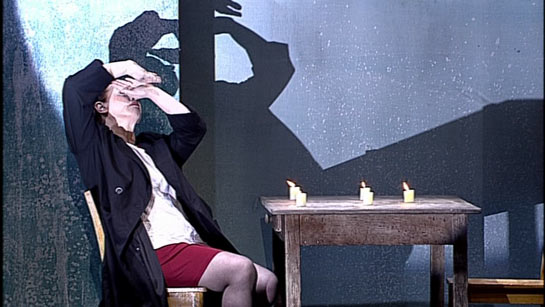
Brünnhilde (Renate Behle) is punished in the Stuttgart Walküre.
OperMachtTheaterBilder: Neue Wirklichkeiten des Regietheaters is a collection of papers from a public seminar in Munich in July 2005, the theme of which was opera productions mostly at the Bavarian State Opera. There are ten contributing authors, whose subjects range from Claudio Monteverdi’s Il ritorno d’Ulisse in Patria (1640) to Wolfgang Rihm’s Die Eroberung von Mexiko (1991). The cornerstone of the book is to be found in the last two chapters, where the authors deal with two notable postmodern productions of Richard Wagner’s Ring, in Stuttgart and in Munich. These two contributions will be examined here.
The visual arrangement of the book title contains in itself the clue to understanding the central message: the missing spaces between the capitalised words invite the reader to find alternative readings – not just ‘opera makes theatre images’, but also ‘opera, power, theatre, images’ (Macht means both). And if you reverse the order, the title may be read as Bildertheater macht Oper, since many of the productions analysed in the book are typical examples of Bildertheater (vision theatre). The title alludes to the fact that opera creates both outward and inward theatrical images, and that this side of opera is much more powerful than we are wont to believe. The visual factor is a strong ally and opponent of the text and music in the score, so it is very rewarding to have a number of thorough analyses of the visual side of opera – and, to boot, a number of superb photos from the productions in question.
Professor Jürgen Schläder from the Department of Theatre Studies at the University of Munich is the anchorman of the book, and he is also the author of its most important article: ‘Kontinuität fragmentarischer Bildwelten: Postmoderne Verfahren im Stuttgarter Ring von 1999/2000’ (Continuity of fragmentary image-worlds, Pp. 191–218). Schläder starts his article with an extensive investigation of the postmodern elements of the Stuttgart Ring. He points out that the production follows a typical postmodern narrative pattern, in that its fragmentary image-worlds highlight the spiralling repetitions in the plot structure. The Stuttgart team has noted that each part of the cycle begins in the underworld or on the earth and then moves upward to end with a disaster-like situation on the level of the gods, which has led to a rendition of the Ring as one tragedy (Rheingold) with three tragedy variations (Walküre, Siegfried and Götterdämmerung). This segmentation is in no way at odds with the overall structure of the Ring, because Wagner already has designed the four music dramas to be able to be performed separately.
It was the Intendant at the Stuttgart State Theatre, Klaus Zehelein, who first decided to let four different directors, set designers and teams of singers interpret the four parts of the Ring; only the conductor, Lothar Zagrosek, is the same all the way through the tetralogy. The directors are: Joachim Schlömer (Rheingold), Christoph Nel (Walküre), Jossi Wieler (Siegfried) and Peter Konwitschny (Götterdämmerung). The four stagings have, as Schläder says, several things in common:
- they avoid, for example, all the naturalistic landscape settings that Wagner prescribes
- they prefer claustrophobically closed spaces instead
- the narrative method is analytical and dramaturgical rather than psychologically realistic
- the mood oscillates between comic playfulness and tragic disillusion, both often staged with outspoken critical distance and irony
One may, as the author points out, wonder at the fact that so many scholars and directors have for so long insisted on seeing the Ring as a continuous, determined effort to reach the end, when it is well known that Wagner wrote not just one, but several endings to the Ring, ranging from the optimistic, Feuerbach-inspired ending in which the gods survive, to the considerably more pessimistic Schopenhauer ending in which the gods perish.
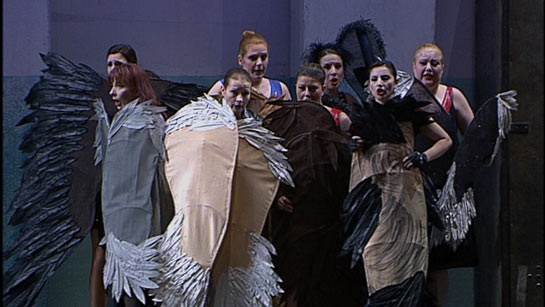
Zu uns floh die Verfolgte: Valkyries in Stuttgart Ring Walküre.
Another argument for not viewing the Ring as a teleological narrative is the nature of the leitmotifs. They do not, according to Schläder, function as recollecting reminiscence motifs, but as constellations of known and new aspects, which the drama can put to use in its further development. The Stuttgart Intendant Klaus Zehelein’s own favourite example against the Ring as a teleological narrative is, says Schläder, the intrusion of the Sword motif at the end of the Rheingold. Wotan must, at the cue of this motif, according to Wagner’s stage directions, take up a battered sword from the floor and with it point to his newly constructed Valhalla castle. The Sword motif penetrates the musical surface, flourish-like, as a reflection of the new ‘great idea’ that suddenly comes to Wotan. As we have never heard this motif before – it occurs only this once in the whole of Rheingold – it cannot be labelled a reminiscence motif: it is an anticipating motif, pointing forward to Die Walküre and symbolising future deeds. The lack of foundation for the Sword motif in Das Rheingold itself makes it impossible, however, for it to act as a convincing provider of coherence between the two operas. The motif should instead be considered an important partial aspect of the drama, which pierces the totality and in claiming full attention makes the previous narrative of the Ring obsolete.
Here, it would have been to the point if the author had rendered these interesting postmodern deliberations more tangible with an example from the Stuttgart production itself, not least because Klaus Zehelein was actually the dramaturg for precisely the Rheingold part. Let me add that Wotan at this point in the Stuttgart Ring has been washing his hands in a basin and after that greets the castle of Valhalla, displaying his ‘clean’ hands to the flourish of the Sword motif. Should I offer a bit of analysis of this gesture, I would say that it seems to act out the Sword motif’s postmodern, emphatically forward-pointing quality with its ensuing outdating of the previous narrative. Wotan has been acting in a morally reprehensible way through all of Rheingold, he has left behind a number of victims, and now he is ‘washing his hands’ so that no one will be able to trace the dirty means he used to reach his goal. This cleaning underscores the attempt of the power-seeking Wotan to cover up the destructive actions he has been perpetrating during Rheingold. He denies the past and holds up the ‘great idea’ of the sword to his audience instead, in order to convince us that it is his right to avail himself of Valhalla, the coveted stronghold. Parallels to powerful handwashers in our present-day reality are not hard to find.
Less convincing is Schläder’s attempt to counter Carl Dahlhaus’s interpretation of the final image in the Ring. According to Dahlhaus, the beginning and the end are joined as diametrical opposites, because the drama is set off by Alberich’s will to power at the cost of love, but concludes with the opposite, the will to love at the cost of power. This connection is visualised, Dahlhaus says, in the final image of the burning Valhalla and the swelling Rhine. Schläder rejects this interpretation and argues that the final image recapitulates only the plot of the first two operas of the tetralogy, Das Rheingold and Die Walküre, and does not cover the plot of Siegfried and Götterdämmerung. But the image does in fact cover the two last operas, because it is not just Valhalla that burns: the hall of the Gibichungs is also burning, and it belongs only to Götterdämmerung, while the love union of Siegfried and Brünnhilde on the funeral pyre unmistakably points back to their first meeting within the fiery circle in Siegfried.
In Stuttgart, any form of linear total narrative is generally renounced. Discrepancies and fractures of the work are lifted to the surface and commented upon. The main priority is not what is being told, but how it is being told, and this is frequently highlighted by meta-theatrical means. The most successful example of such a meta-theatrical comment, in my view, occurs in the final scene of Konwitschny’s outstanding Götterdämmerung. Here the decisive break in the development of Brünnhilde’s character, from vengeful virago in the second act to all-knowing commentator in the third, is accentuated in a most elegant way. Brünnhilde enters, dressed in a modern bright red suit, examines the slide projector used onstage, turns it off, wakes up the ‘bodies’ of Gunther and Siegfried and sends them in a friendly way, but firmly, off into the wings. The stage is hers, everything has been cleared, and now is the time to take stock. It is the singer behind the Brünnhilde character who in this fashion sheds the fiction and holds it out for all to see. This makes us, as audience, realise that Brünnhilde is in fact two persons: a semiotic, fictitious character, and a phenomenological, real singer. The two of them have gained consciousness of their role, and now they conspire to judge the work they have been a part of. It is an alienation effect which really works.
Speaking of singers: the four different teams of singers in Stuttgart have opened up a hitherto unused way of depicting the extreme vocal and bodily development of the protagonists.
Brünnhilde in Die Walküre is acted by a raw-boned singer with a gritty timbre, in Siegfried she is replaced by a plump and sensually purring feline type, and in Götterdämmerung she is finally transformed into a self-assured, volcanic, motherly personality.
Siegfried in Siegfried is impersonated by a stout and strapping Heldentenor, but in Götterdämmerung he is replaced by a slender operetta tenor, who seems to have landed in ‘the wrong show’; he is simply not competent to look through the complicated intrigues unfolding around him.
The Wotan character is handled rather roughly and critically in all three parts: in Das Rheingold he is a sedate, bespectacled wearer of a dressing gown and owner of a sanatorium, in Die Walküre he emerges as a chubby, contact-shunning, henpecked hubby with a ridiculously oversized reed for a spear, in Siegfried he turns into a greying, pistol-wielding toughie with a water pipe for a spear, and in Götterdämmerung we have to imagine for ourselves what he looks like, for he does not burn up onstage, but rather inside our minds, while Wagner’s concluding stage directions are projected onto the curtain as rolling titles.
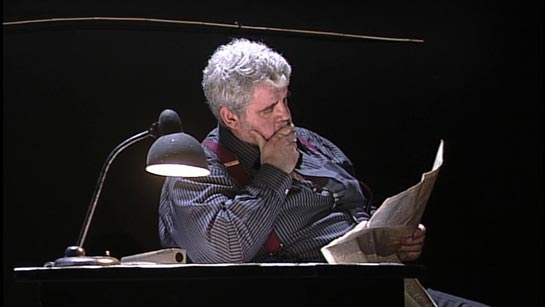
Wotan (Jan-Hendrik Rootering) won't listen to Brünnhilde's petition in the Stuttgart Walküre.
This minimalist ending is a gift to the audience, whose imagination is put on high alert; the music increases in importance, withall the essential leitmotifs surging forth from the orchestra pit, from which an immense, apocalyptic sea of sound rises to engulf us. The sensuality of the music unites the audience in a shared bodily experience, but the philosophical meaning of the Ring is something we will have to determine ourselves.
In short, Schläder manages convincingly to expound the postmodern elements of the Stuttgart Ring. His article is fascinating and well written, and his analyses open-minded and knowledgeable. The Stuttgart Ring will never be the same to me after reading Schläder’s paper. Minor errors, such as calling Brünnhilde a half-goddess (206), cannot dilute the fact that this is a very valuable piece of Wagner literature.
The other Ring article in OperMachtTheaterBilder is Wolfgang Willaschek’s ‘”Against Interpretation”: Zwischen Wohnzimmer, Schrotthalde und Niemandsland: David Aldens Münchner Ring’ (Between living room, scrap heap and no-man’s-land)( Pp. 219–49). Willaschek has been employed as a dramaturg at several opera houses, in Hamburg and San Francisco among others, and his treatment of the Munich Ring is characterised by a very personal, dramaturgical angle, completely bare of the theoretical foundation in which Schläder’s article excelled.
He begins by recounting the background of the Munich Ring. It should have been staged in its entirety by Herbert Wernicke, but the American-born director David Alden was called in to adapt the project when Wernicke died suddenly in 2002. At this point, the concepts for all four parts of the Ring were drawn up, the sets designed and the performers hired. Wernicke had managed to stage Das Rheingold, the preliminary evening to the Ring, and this staging remained unchanged, while Alden, tremendously pressed for time, embarked on the Ring narrative itself, starting with Siegfried, continuing with Götterdämmerung and finishing with Die Walküre. Willaschek has chosen to follow Alden’s order of productions, a bold but thought-provoking idea, for who can really tell where a ring begins and ends?
The style and structure on which Alden’s Ring is based have to do with a contrapuntal reading of the work – with the deconstruction of it, Willaschek informs us. And he has it from a reliable source: the dramaturg of the production, Nike Wagner. What happens onstage is not just miming the text and the music, it is commenting on the text and the music. Alden has abandoned unity and continuity and opted for deconstruction instead. He takes his audience, as Willaschek mentions, through some very different spaces: In Siegfried we begin in Mime’s smithy, which has for this occasion been transformed into a car repair shop; from there we are led on to a fantastic Fafnerian country with giant eggs (Willaschek calls it the primordial landscape); after that we arrive at a crossroads, and following a visit to a magnificent villa we finally end up in a dream-like blue room (in Die Walküre). Alden indulges in a great deal of fun and frivolity. In Stuttgart there was no jollity, gaudiness, or drinking on the stage; in Munich it is abundant. Mime gives away his murderous intentions towards Siegfried, for example, because he is absolutely plastered after having celebrated Siegfried’s victory over Fafner with Siegfried and the Woodbird (who is, in this version, a ditzy party girl).
Willaschek writes vividly about the Munich Ring, and his enthusiasm is so contagious that you feel almost as if you were among the audience. Unfortunately he himself often falls into the trap that the postmodern theatre he is analysing tries to evade at all costs. With reference to Siegfried, for instance, he stakes a claim to the ‘meaning’ of the opera, saying, ‘Siegfried is actually about the quest for identity’ (221). Yes, that is what it is to him in the context of this production, but Siegfried has several chords to strike, and this is just one of them – although a frequently sounded one.
Even more dubious is his interpretation of the traffic light which Alden has put into the meeting of Wotan and Siegfried in Act III, Scene 2, and which is forever changing from red to green and back again. Willaschek finds in this traffic light a reference to the twelve-year break Wagner took from his work on the Ring from 1857 to 1869. The traffic light demonstrates Wagner’s own uncertainty about when to start the work again, he says (230). The problem is that Wagner did not interrupt his work on the Ring at this point at all: he had put his manuscript aside in Act II, Scene 2, where Siegfried has lain down to rest under a lime tree in the forest and is wondering what his parents might have looked like. While all interpretations are subjective, that does not mean that all are equally valuable; the supporting arguments may be more or less convincing, and Willaschek’s arguments belong, in my view, to the lesser kind. Allow me to present as an alternative interpretation that the traffic light could be seen as a commentary on Wotan’s wavering, as an everyday visual expression of the character’s ‘stop–go’ behaviour. Wotan’s conduct is generally marked by sudden shifts between passive reserve and active intervention, but its ‘stop–go’ mode is unusually conspicuous in this scene. Wotan has been planning for years that the heroic Siegfried and no one else should wake his daughter Brünnhilde from her slumber, but now the young hero behaves so impertinently, so condescendingly towards him that he does a U-turn, discards his role as the passive observer, and bars the way to Brünnhilde. The ‘free one’ should not feel too free, after all.
In general, Willaschek’s article is a mixture of good and bad ideas. Without knowing for certain – regrettably, I have not seen the Munich Ring myself – I suspect that Alden’s staging aims at highlighting the ambiguous aspects of the Ring; Willaschek, by contrast, is rather given to unambiguous interpretation – even though he invokes Susan Sontag’s famous essay ‘Against Interpretation’ in his own article. I might have preferred Willaschek to be less willing to put things into place and more willing to set things in motion. In numerous passages, though, he succeeds in conjuring up the many more or less whimsical, more or less crazy brainchildren of Alden’s so vividly that all our capacity for experience is stirred, which is in itself a feat of art. And at least he does acknowledge that his interpretations of this postmodern work by Alden are subjective.
Regietheater demands a lot of its audience. Its images are never mere entertainment or mere complacency: they want to tell us something important about our lives today, and they often do it with harsh and provocative means. The theatre images of Regietheater provide views on our new life-realities, phrased in the language of theatre, as is stated in the introductory chapter of the book. If one finds the methods of Regietheater hard to comprehend, one may benefit from this book, but it implies – like Regietheater itself – a willingness to do away with prejudice and put in a bit of work in order to make oneself familiar with the matter.
It is a serious misconception to believe that Wagner’s scores are autonomous: the sole fact that the composer could never have sung his work himself proves it. A composer is dependent on other artists – directors, conductors, set designers, singers and so on – who can lend shape and colour, body and sound to a score and thus add new artistic dimensions to the work. The heteronomy even includes the audience, because ultimately, the fulfilment of the work depends on the unique interaction between stage and auditorium during every single performance. This is where the work lives, where it is tried and tested, and where it imperceptibly changes its meaning. The moral must therefore be: resist the desire to possess the Ring, it cannot be grasped.
This article has previously been printed in The Wagner Journal and is republished with permission.
Stuttgart DVD Ring on Amazon
Order The Wagner Journal here
Der Ring des Nibelungen: Articles and Reviews
Nila Parly on Regietheater: Visions of the Ring
The Cry of the Valkyrie: Feminism and Corporality in the Copenhagen Ring
Sam Goodyear, Bayreuth 2022: Der Ring des Nibelungen (Valentin Schwarz)
Mark Berry, Bayreuth 2022: Das Rheingold (Valentin Schwarz)
Mark Berry, Bayreuth 2022: Die Walküre (Valentin Schwarz)
Mark Berry, Bayreuth 2022: Siegfried (Valentin Schwarz)
Mark Berry, Bayreuth 2022: Götterdämmerung (Valentin Schwarz)
Mark Berry: Bayreuth 2017: Das Rheingold (Frank Castorf / Marek Janowski)
Mark Berry: Bayreuth 2017: Die Walküre (Frank Castorf / Marek Janowski)
Mark Berry: Bayreuth 2016: Das Rheingold (Frank Castorf)
Mark Berry: Bayreuth 2016: Die Walküre (Frank Castorf)
Mark Berry: Bayreuth 2016: Siegfried (Frank Castorf)
Mark Berry: Bayreuth 2016: Götterdämmerung (Frank Castorf)
Mark Berry: Bayreuth 2014: Das Rheingold (Frank Castorf)
Mark Berry: Bayreuth 2014: Die Walküre (Frank Castorf)
Mark Berry: Bayreuth 2014: Siegfried (Frank Castorf)
Mark Berry: Bayreuth 2014: Götterdämmerung (Frank Castorf)
Per-Erik Skramstad: Bayreuth 2013: There Will Be Blood: Frank Castorf Has Entered the Ring
Per-Erik Skramstad: Bayreuth 2010: Curtain Down on Tankred Dorst's Ring
Mark Berry: 2010 Cassiers Ring
Sam Goodyear: Laufenberg’s Wiesbaden Ring 2017
Jerry Floyd: Rheingold, Metropolitan 2010
Jerry Floyd: Die Walküre, Metropolitan 2010
Jerry Floyd Washington National Opera: Siegfried
Jerry Floyd Washington National Opera: Siegfried II
Jerry Floyd Washington National Opera: Götterdammerung Concert (2009)
Jerry Floyd Washington National Opera: Götterdammerung Concert (2009)
Mark Berry: Richard Wagner für Kinder – Der Ring des Nibelungen (2011)



